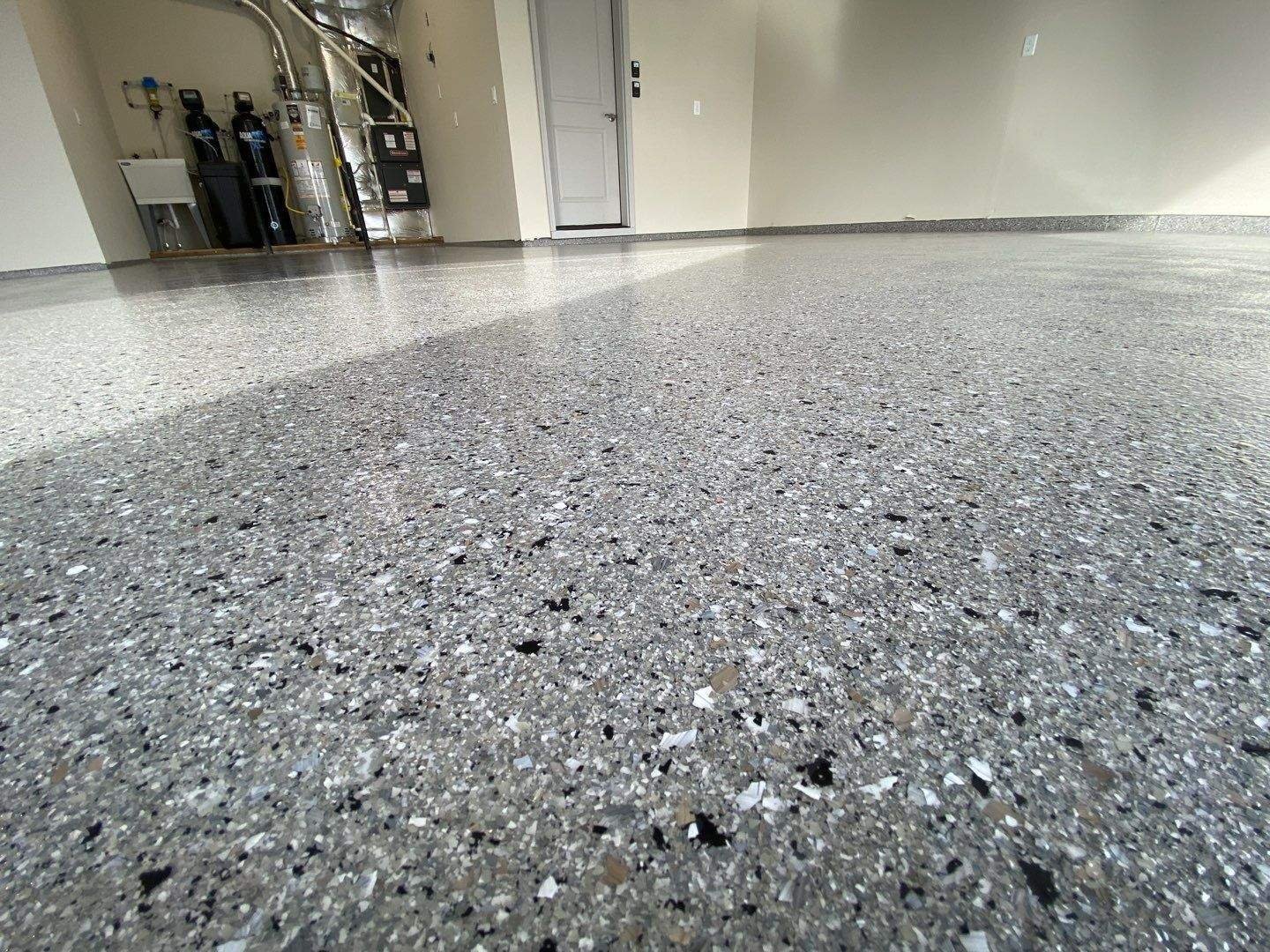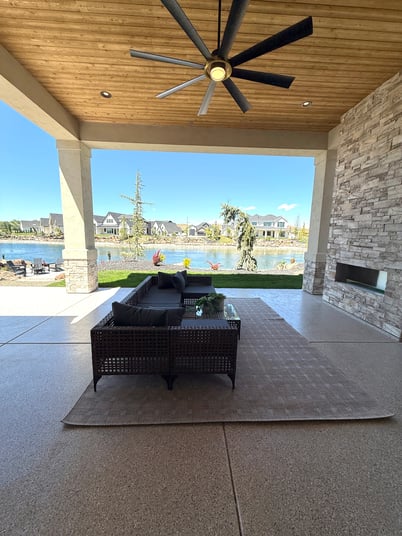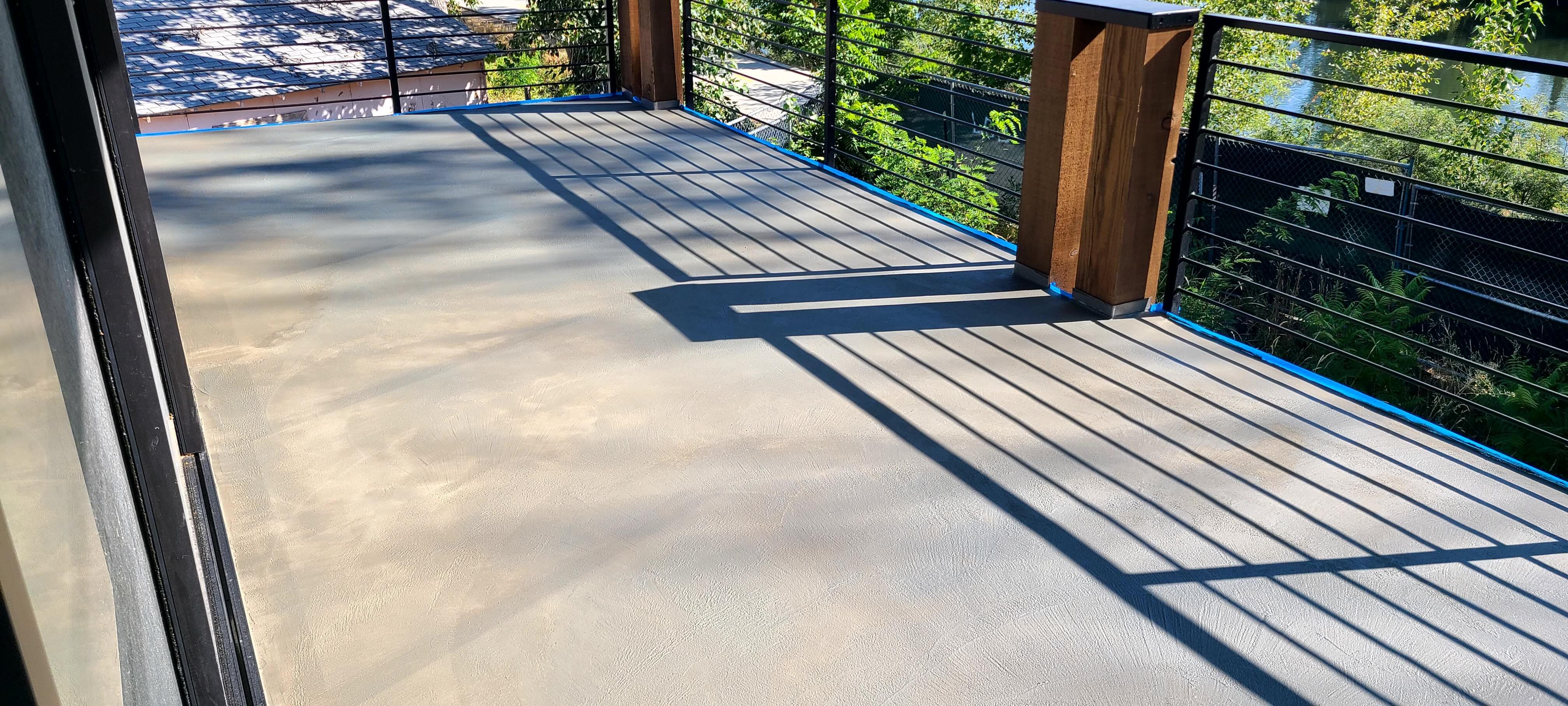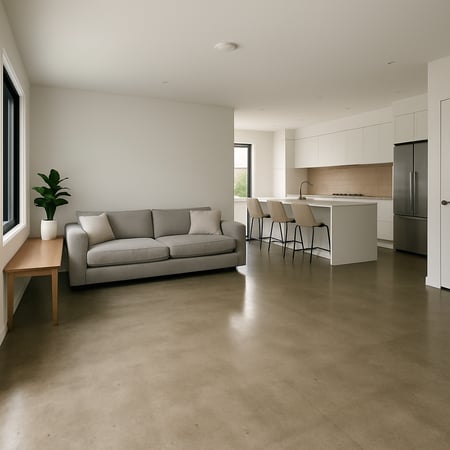
Of all the choices you make as a home builder, what to do with your concrete can feel like an afterthought. Whether it's a dusty garage floor, a sprawling patio, or a luxury pool deck, the wrong surface treatment can undercut the entire project.
At Roe Painting, we've worked with dozens of high-end builders and general contractors to solve this exact issue. We install a full range of concrete floor coatings, from protective sealers to decorative systems, specifically tailored for residential construction. We understand the importance of the timelines, aesthetic standards, and durability expectations you work with, and we help you meet or exceed them.
In this article, you'll get a breakdown of 9 concrete coating systems you can spec with confidence. We'll cover where they work best, what they cost, and what kind of homeowner experience they deliver. Whether you're finishing a garage, resurfacing stamped concrete, or need a waterproof system for an elevated deck, you'll find a proven solution here.
We'll cover:
- Penetrating Concrete Sealers
- Decorative Flake Floors
- Quartz Coatings
- Tidalstone
- Thin-Film Epoxy
- 11/10 for Pool Decks & Stamped Concrete
- ALX Waterproof Deck Coating
- Grind and Seal Coatings
- Newcrete Concrete Resurfacing
1. Penetrating Concrete Sealer - Invisible Protection for Natural Concrete Finishes
Penetrating sealers are ideal when you want to protect a concrete surface without altering its appearance. These sealers soak into the substrate, creating a barrier against moisture, staining, and surface wear without adding a sheen or film on top.
What Is It?
A penetrating concrete sealer is a breathable, non-film-forming product that chemically reacts with the concrete to repel water and other contaminants. It leaves the surface looking untouched, which is often exactly what a discerning homeowner wants.
Builders choose penetrating sealers when the goal is to protect new concrete without compromising a clean, natural aesthetic.
Where it Works Best
- Driveways and walkways where you want to retain the natural look of broom-finished concrete
- Outdoor patios that need UV stability and water resistance without visual change
- Stamped or decorative concrete that doesn't need a topical coating
Why Builders Use It
- Fast application - Minimal downtime or disruption during final construction stages
- Low cost - An affordable way to protect concrete and hand over a project in pristine condition
- Homeowner approved - No color change or sheen means no design conflict, but enhances protection
Typical Cost
$1.25 - $1.75 per square foot, depending on surface condition and size.
| Pros | Cons |
| Virtually invisible finish | No color enhancement |
| Protects against freeze-thaw cycle and salt damage | Will not hide imperfections or discoloration |
| Excellent for exterior concrete surfaces | Will need reapplication every 2-4 years |
2. Decorative Flake Floors for Garages, Shops, RV Bays, and Patios
Decorative flake floors are one of the most requested coating systems for residential garages (for good reason!). They offer a high-end, slightly textured look, strong chemical and impact resistance, and fast return-to-service timelines.
What Is It?
A decorative flake system consists of a solid-color basecoat, broadcast vinyl flakes in a range of colors, and a clear topcoat. Roe Painting prefers to work with polyaspartic coatings for their high durability, UV resistance, and fast cure times, but epoxy can be used as a basecoat, if preferred. Check out this article comparing epoxy, polyurea, and polyaspartic to understand the differences in these popular coatings.
These floors offer the durability of a commercial-grade system with the curb appeal clients expect from a luxury home.
Where It Works Best
- Garage floors - the most common install location
- Shops or RV Bays - easy to clean and maintain while providing protection from excessive use
- Outdoor patios or walkways - elevate standard concrete to create sophisticated entry spaces and outdoor living
- Interior utility or mud rooms and workshops - seamless, easy-to-clean surfaces
Why Builders Use It
- High aesthetic value - Provides a finished, showroom-ready garage
- Durability - Withstands vehicle traffic, tools, and chemicals
- Fast install - Polyaspartic systems can be installed in 1-2 days, depending on the size of the space and prep work required
- Wide color options - Match builder color schemes or homeowner preferences
Typical Cost
$5.50 - $6.50 per square foot for 1/4" flake
$6.50 - $7.50 per square foot for hybrid flake (traction additives can help reduce slipperiness at an additional cost)
| Pros | Cons |
| Excellent abrasion and chemical resistance | Substrate prep is critical; poor concrete can increase cost |
| Non-slip texture and easy maintenance | More expensive than basic sealer |
| UV-stable topcoats won't yellow or fade |


3. Quartz Coatings - Solutions for Home Kennels & Dog Washes
When your clients are building out custom spaces for pets like indoor dog washes, home kennels, or utility rooms, quartz coatings offer an ideal blend of hygiene, slip resistance, and durability.
What Is It?
Quartz coatings are multi-layered systems that incorporate colored quartz aggregate into resin layers for a textured, highly durable finish. They're commonly used in commercial kitchens and veterinary clinics and are now gaining popularity in luxury residential applications.
This is the system to spec when your client needs a sanitary, easy-to-clean surface that can handle moisture, animals, and chemicals.
Where It Works Best
- In-home dog wash stations
- Kennels or pet room floors
- Mudrooms or laundry areas with wet-zone exposure
- Outdoor runs or pet relief areas
Why Builders Use It
- Superior sanitation - Seamless surface means no grout lines or pores for bacteria
- Slip resistance - Textured finish reduces risk in wet areas
- Commercial-grade strength - Designed to withstand cleaning agents and wear
- Moisture resistance - Withstands standing water and frequent rinsing
Typical Cost
$8.00 - $12.00 per square foot, depending on area size, slope, and number of coats required
| Pros | Cons |
| Seamless and easy to clean |
Overkill for standard living areas |
| Slip-resistant even when wet | Textured finish may not be preferred in barefoot areas |
| Durable in high-traffic or high-moisture areas |

*AI rendered image
4. Tidalstone - Matte, Stone-Like Finish for Upscale Elegance
When clients want the natural look of stone without the slipperiness or irregularity of pavers, Tidalstone delivers a sophisticated, slip-resistant finish that's as durable as it is beautiful.
What Is It?
Tidalstone is a matte, stone-look coating system (similar in composition to the flake floor coatings) that mimics a more natural stone aesthetic with all the benefits of a protective coating. It's especially suited for outdoor dining areas where design cohesion matters as much as performance.
Where It Works Best
- Patios and porches where homeowners want a more refined surface than standard flake or broom-finished concrete
- Walkways and entries that need slip resistance without sacrificing appearance
- Outdoor kitchen and firepit areas requiring stain resistance and visual appeal
- Indoor spaces that want a modern feel that's highly functional and easy to clean
Why Builders Use It
- Modern aesthetic - Helps outdoor spaces match or elevate the home's architecture
- Homeowner approved - Soft, matte texture is comfortable underfoot and visually high-end
- Functional and safe - UV-stable and cooler to the touch than many traditional coatings
Typical Cost
$7.00 - $8.00 per square foot, depending on traction additives and prep complexity
| Pros | Cons |
| Designer aesthetic without the maintenance of pavers or tile | Not ideal for garages or heavy vehicular traffic |
| Cooler under direct sunlight | Requires careful prep to achieve a consistent appearance |
| Pairs well with high-end landscaping and architecture | Higher cost |
| Works well indoors and outdoors |

5. Thin-Film Solid Color Epoxy - Budget-Friendly Protection with a Clean Look
When you're working with a tighter budget or finishing secondary spaces that still demand protection and polish, thin-film epoxy offers a straightforward solution. It's cost-effective, clean-looking, and still a major upgrade from bare concrete.
What Is It?
Thin-film epoxy is a solid-color, two- to three-coat system applied directly to prepared concrete. Unlike thicker broadcast or decorative systems, this coating adds a uniform color and protective barrier without texture or aggregate.
This is the go-to system for builders needing a clean, finished look without the price tag of high-end decorative coatings.
Where It Works Best
- Garages in mid-range or spec homes
- Porches and walkways
- Mechanical rooms, storage areas, and workshops
- Interior utility spaces like mudrooms, laundry rooms, and basements
- Homeowner budget-conscious projects where coating is still a value-add
Why Builders Use It
- Cost-effective - Provides surface protection at a lower price point
- Quick turnaround - Fast to install and cure
- Customizable - Solid color options allow for clean, aesthetic finishes
- Protects concrete - Reduces dusting, staining, and moisture issues
Typical Cost
$3.00 - $4.00 per square foot, based on area size and prep needs, add a UV-stable topcoat for exterior use (+$1.50 per square foot)
| Pros |
Cons |
| Affordable, entry-level coating | Offers no decorative flake and minimal texture |
| Clean, professional appearance | Less durability than other coatings |
| Easy to clean and maintain | Can show wear in high-traffic or UV-exposed areas over time |

6. Westcoat's 11/10 System - Textured Coating for Pool Decks, Stamped Concrete, & More
If you're looking to upgrade or restore aging or stamped concrete, the Westcoat 11/10 system offers a slip-resistant, breathable, visually appealing finish, without the need to tear out existing concrete.
What Is It?
Westcoat's 11/10 is a concrete resurfacing and texture coating system made for horizontal outdoor concrete. It's especially effective on stamped or broom-finished slabs that are weathered, faded, or uneven in appearance. The system includes a cementitious base and a pigmented sealer that delivers a refreshed, UV-stable surface.
Builders use this system to give tired concrete new life, especially in high-traffic outdoor areas like pool decks and patios.
Where It Works Best
- Pool decks in need of slip resistance and UV durability
- Stamped or decorative concrete that's faded, cracked, or stained
- Patios and breezeways that require a consistent, low-maintenance finish
- Outdoor gathering spaces where the homeowner expects aesthetic consistency
Why Builders Use It
- Extends the life of existing concrete - Avoid costly demo and repour
- Designed for outdoor use - UV stable, breathable, and won't trap moisture
- Slip resistance - Important for wet environments like pools and spas
- Color options - Tinted sealer allows for cohesive design coordination
Typical Cost
$5.00+ per square foot, depending on prep and project size
| Pros | Cons |
| Restores and protects stamped or decorative concrete | Not suited for vehicular traffic or interior use |
| Customizable traction options and cooler underfoot | |
| Breathable system prevents moisture-related failure | |
| Budget-friendly alternative to full replacement |

7. ALX - Waterproof Decking for Elevated Living Spaces
When your project includes elevated concrete or plywood decks, creating a watertight surface is critical for longevity and aesthetics. The ALX system is a high-performance waterproof coating that creates a walkable surface over elevated decks and balconies.
What Is It?
ALX is a metal-lath reinforced, cementitious waterproof decking system that's finished with a durable, textured topcoat. It's designed specifically for elevated applications where both appearance and water protection are mission-critical.
Builders specify ALX when they need a zero-leak solution for second-story outdoor living without sacrificing design.
Where It Works Best
- Elevated decks or balconies with living space or garages underneath
- Exterior walkways with weather exposure
- Rooftop patios or above-grade terraces
- Multifamily or custom residential projects requiring code-compliant waterproofing
Why Builders Use It
- Meets waterproofing code - Helps you pass inspections with a tested, proven system
- Custom finishes available - Choose textures and colors that match the home's palette
- Durable surface - Holds up to foot traffic, furniture, and weather exposure
- Peace of mind - Minimizes risk of leaks, rot, or water damage long-term
Typical Cost
$12.00 - $15.00 per square foot, depending on deck substrate, access, and finish options
| Pros | Cons |
| Fully waterproof, code-compliant system | Higher cost due to labor and materials |
| Aesthetic finish options | Requires multiple install stages, so planning around construction schedule is key |
| Durable underfoot for outdoor living | |
| Prevents costly future repairs from water intrusion |

8. Grind & Seal - Industrial Look for Modern Homes
If your client is leaning into a modern, minimal, or industrial design aesthetic, a grind and seal system delivers that raw, polished-concrete look while still protecting the surface from wear and staining.
What Is It?
Grind and seal is a process where the concrete surface is mechanically ground to ensure proper adhesion of the coating, then sealed with a clear topcoat. Unlike polished concrete, it does not require extensive densifying or multiple polishing passes—making it faster and more budget-conscious.
Builders use grind and seal to give clients that "loft-style" or warehouse-inspired visual without the time or cost of full polishing.
Where It Works Best
- Basements, home gyms, or modern living areas
- Garage interiors
- Open-plan homes where a seamless industrial surface is desired
- Converted spaces (barns, workshops, etc.) that need an elevated finish
Why Builders Use It
- Cost-effective alternative to polished concrete
- Delivers a trendy, architectural finish homeowners love
- Faster to install than polished concrete or full epoxy systems
- Low maintenance and easy to clean
Typical Cost
$3.00 - $4.00 per square foot, optional staining for customizable color
| Pros | Cons |
| Industrial, modern aesthetic |
May show imperfections in the existing slab |
| Shows off concrete's natural variation and character | Less durable than flake or quartz coatings in high-impact areas |
| Faster install than polished concrete | Needs re-sealing over time, especially in wet or UV-eposed spaces |
*AI rendered image
9. Newcrete - Concrete Resurfacing for Damaged Concrete
No matter how careful the crew, construction often leaves concrete blemished with scuffs, chips, stains, or worse. When replacing the slab isn't an option, Newcrete offers a concrete resurfacing solution that saves time, preserves budget, and leaves a clean, uniform finish.
What Is It?
Newcrete is a cementitious overlay system that bonds to and strengthens damaged concrete. It creates a surface that is stronger and more resistant to stains, ice melt, and chemicals than untreated concrete. It is the ideal solution when you need to correct issues with damaged concrete without ripping it all out and repouring.
Where It Works Best
- Driveways and patios
- Walkways and entry paths
- Outdoor slabs
Why Builders Use It
- Saves the slab - Avoid the expense and disruption of demolition and repouring
- Consistent finish - Ideal for correcting patchy or mismatched surfaces
- Fast turnaround - Surface can often be prepped and coated within days
- Homeowner-friendly - Holds up against ice melt and UV damage
Typical Cost
$3.00 - $4.00 per square foot, based on surface area and level of prep
| Pros | Cons |
| Restores damaged or stained concrete | Not suitable for structurally compromised (heaving) concrete |
| Saves cost vs. full replacement | Not fully customizable |
| Fast install. Can help meet building deadlines. |

Protect the Concrete, Protect the Build
You now have a clear view of nine concrete coating options and when each one makes the most sense. Whether it's a garage, patio, pool deck, or walkway, there is a solution that fits the job.
Concrete is often the last detail to get attention, but it plays a big role in the final look and feel. If it looks rough or unfinished, it can take away from everything else you've built.
If you're working on a custom home and need help choosing the right coating, or you're trying to clean up a surface before the final walk-through, give us a call. We're happy to take a look and give you an honest recommendation.
At Roe Painting, we help builders deliver a finished product that looks sharp and holds up over time. If you want your concrete to match the quality of the rest of the project, we're ready to help.
To learn more about our concrete coating services for your home builds, request a quote, and our team will set up a time to walk through your options.
Jud has been with Roe Painting since 2017 and in the painting industry as a whole since 1999. He has a passion for estimating and selling a wide variety of painting projects. As the son of two teachers, he loves to educate his customers on what they should expect in a proper paint job. As VP of Sales, he enjoys developing estimating programs and teaching and coaching his sales team to deliver a confident contracting experience for every customer.
Topics:
.jpg?width=350&height=467&name=image001%20(1).jpg)

